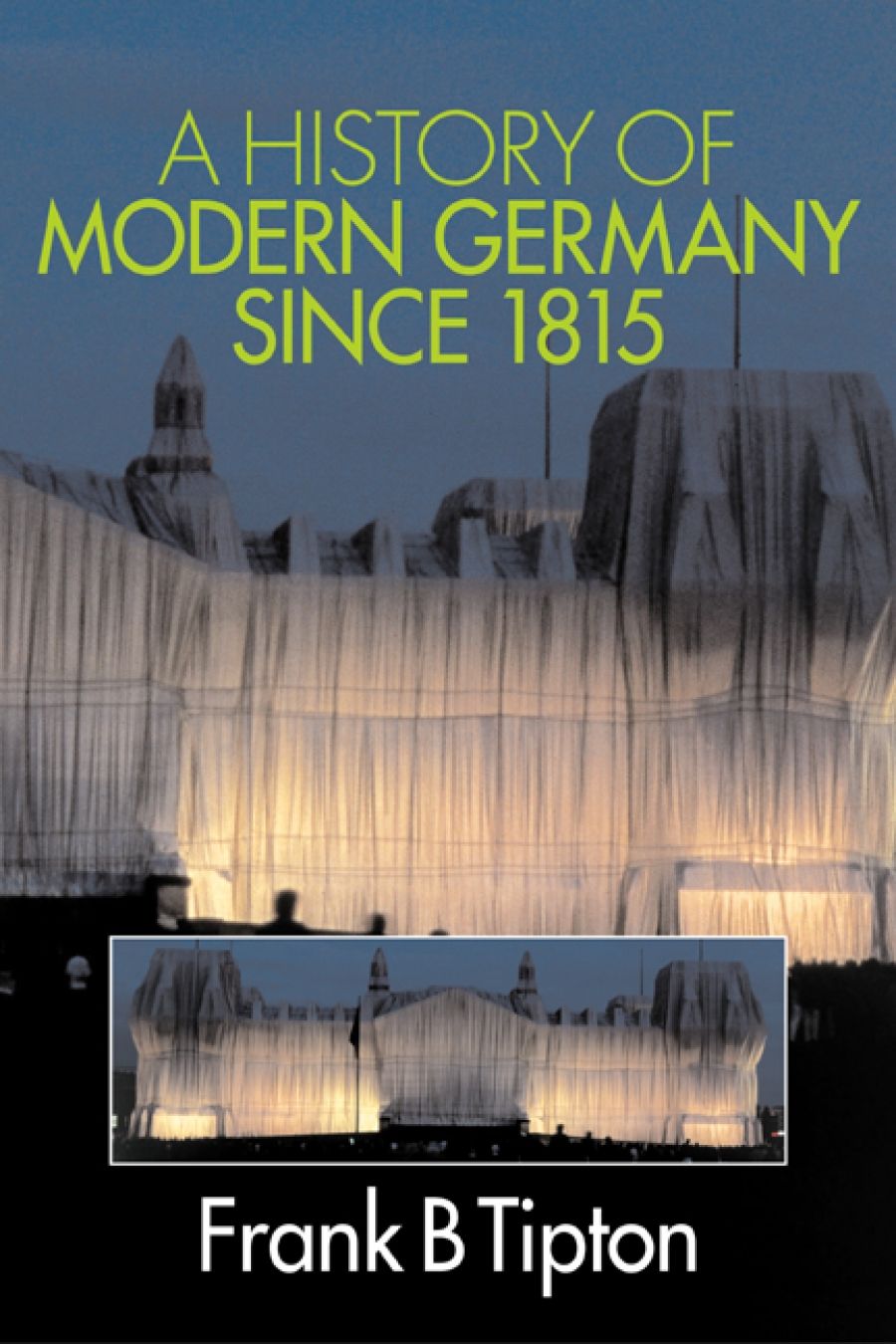
- Free Article: No
- Contents Category: History
- Review Article: Yes
- Article Title: Wrapped secret
- Online Only: No
- Custom Highlight Text:
Books, of course, should not be judged by their covers. In this case, however, the choice of cover illustration – the historic Reichstag veiled in silver fabric by the Bulgarian–American ‘wrap artist’, Christo – seems unusually significant, and not only because the author devotes his concluding remarks to it (more about that later). German history is a well-ploughed field. With library shelves groaning under the weight of books on the subject, only the narrowest studies, aimed at specialised markets, will offer much that is really new. The only justification for yet another narrative history of modern Germany – and with a title as blandly generic as this one – is therefore that a familiar story will be presented in a new wrapping.
- Book 1 Title: A History of Modern Germany Since 1915
- Book 1 Biblio: Continuum, $55 pb, 748 pp
Frank B. Tipton explicitly distances himself from the Sonderweg approach, stressing that ‘Germany was not uniquely pathological’. Nor does he believe in privileging any particular aspect of its history over others. He enfolds the familiar political history in a plush fabric of social, economic and cultural narrative, satiated with statistical data, anecdotes and thumbnail sketches. On the large canvas of 700-odd pages, this adds up to a kind of pointillist panorama: if one takes the required step back, the many little dots make up a brightly coloured picture. Tipton forces the reader to do this by the simple device of using successive generations and their experiences as his structuring principle, and characterising these in broad cultural terms such as ‘romantic’, ‘revolutionary’, ‘realist’, ‘modernist’, ‘postmodernist’, ‘neo-realist’ – each introduced by a representative work of art. The pitfalls of undue homogenisation are avoided by scrupulously observing the fragmentation of each generation along lines of class, interest group, region, and gender. This is clearly a work influenced by contemporary postmodernist historiography in its emphasis on polyphony and heterogeneity, and in its reluctance to theorise and impose a grand narrative.
Students will find it a thought-provoking mine of detailed information, written in an easy style that avoids jargon and theoretical abstraction. They might feel, however, and with some justification, that this brick of a book could have become more portable by cutting out tedious detail and redundant gossip, intrigued though some of them might be to read about Hitler’s genitalia. And while it is always welcome to see an economic historian transgress the boundaries by trying his hand at art appreciation and film criticism, there are some strange lapses in his own specialist field. There is, for example, not a single mention of Bretton Woods – neither in the discussion of the ‘economic context’ of the transition from the postwar era to neoliberal globalisation, nor in his earlier discussion of postwar economic reconstruction. This is a crippling omission, as it is plainly impossible to make sense of these epochal changes without explicitly referring to the post-war system of fixed exchange rates based on the dollar gold standard and its breakdown. It is also symptomatic of Tipton’s failure to break with one of the most enduring weaknesses of the ‘national histories’ tradition: the almost exclusive preoccupation with endogenous factors.
In the end, all books on German history stand or fall with Hitler. Tipton’s chapters on the demise of the Weimar Republic, the rise of the Nazis, the Third Reich, and the Holocaust show the same strength and weaknesses as all other chapters: a solid narrative and accessible introduction to the key issues, but little in the way of commitment to an explicit explanation. Although he takes pains to provide a balanced review of the major controversies concerning the origins, nature, and workings of the Nazi régime, his sympathies for views that stress the classless character of the party’s support, the centrality of anti-Semitism to its ideology, the broad popular support for the régime, and the general complicity with, or at least knowledge of, the Holocaust of most ordinary Germans shine through. This leads him to view the postwar Germans and their efforts at Vergangenheitsbewältigung (coming to terms with, or overcoming the past) through somewhat jaundiced eyes: even the anti-fascism of the leftist ‘sixty-eight generation’, it is suggested (by Tipton’s favourite technique of selectively quoting others while not directly expressing a view himself), is tainted by its failure to ‘rid themselves of anti-Semitism’, as evidenced by a pro-Palestinian and anti-Israeli stance.
Consistent with this, the book ends on the disquieting note of possible unfinished business. Referring to the cover motif as a ‘concluding symbol’, Tipton suggests that the seemingly enlightened official support for Christo’s wrapping of the Reichstag may have served to ‘make the world forget the […] mournful footsteps echoing through Germany’s two hundred years of modern history’, and that the veiled Reichstag ‘stands as a symbol of the ambiguous nature of the German past – hidden, closed, ominous, concealing some portentous and possibly dangerous secret.’
It is a shame that, even after 700 pages of often enlightening, thought-provoking and informative reading, we never quite find out what that secret might be.


Comments powered by CComment